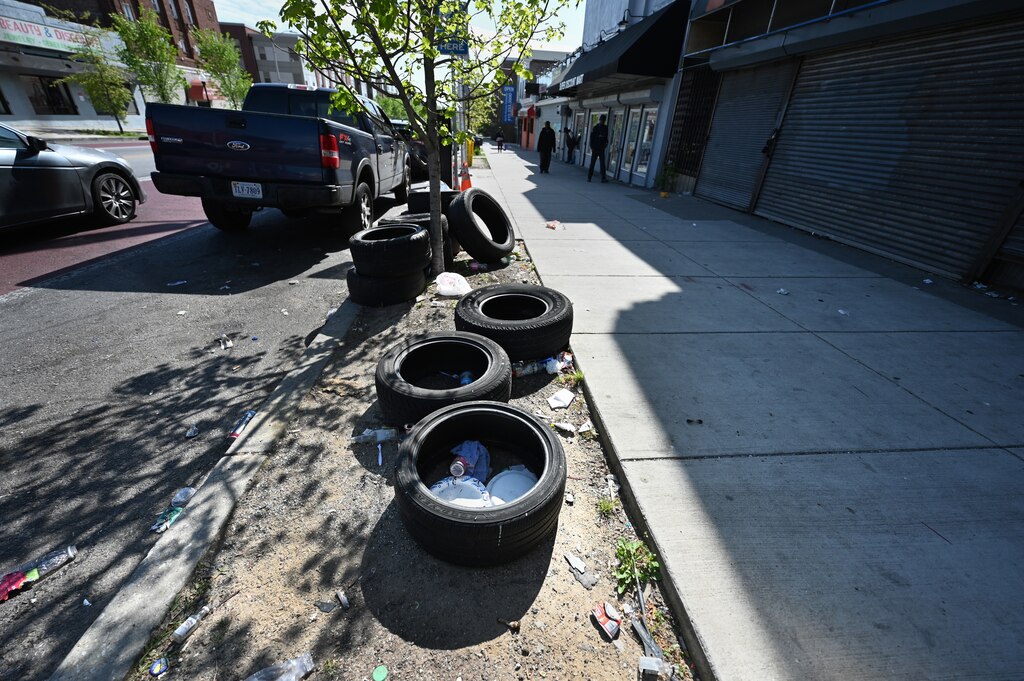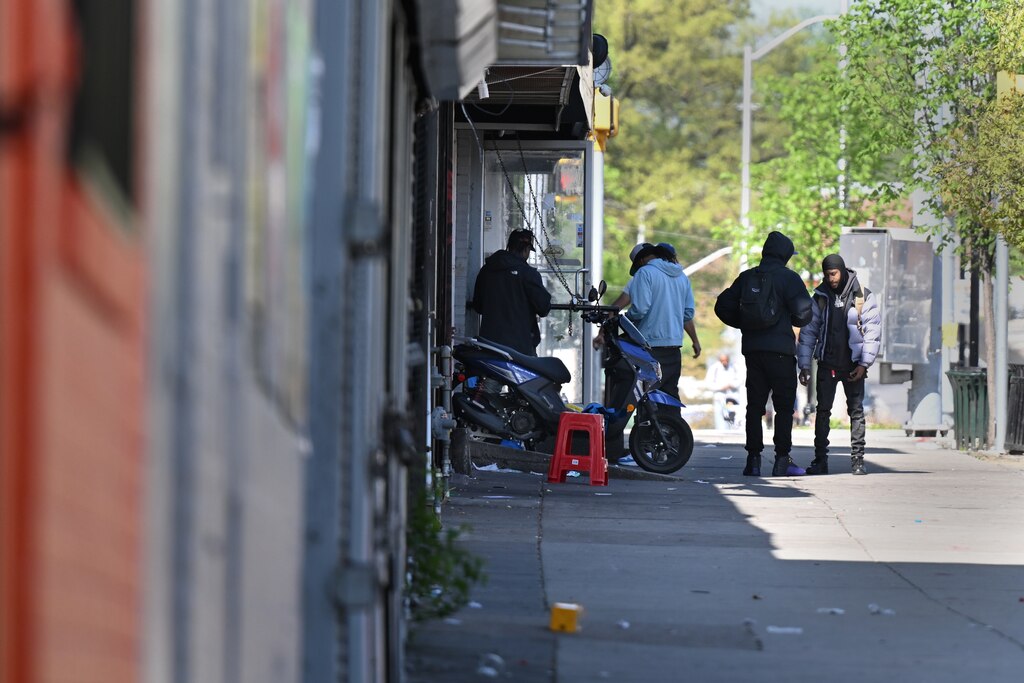There’s a stretch of North Avenue, on the far west end between Poplar Grove Road and Bloomingdale Avenue, that stays on Sheila Dixon’s mind.
It’s not a particularly remarkable segment of the east-to-west roadway that slices Baltimore’s inner city from its northern half. If anything, it looks a lot like other segments of North Avenue, with dilapidated facades and vacant buildings lining the litter-filled street.
“It’s filthy!” Dixon said.
The businesses in the occupied storefronts aren’t particularly noteworthy, either, some residents say. There are a handful of carry-out joints, pawn shops and, in a one-block stretch, five run-down convenience stores selling mostly the same stuff — soda, lottery tickets, rolling papers, candy. But it’s not the businesses on Dixon’s list of grievances — though she blames them to a degree — it’s the people who hang out in front of some of them.
The Baltimore Banner thanks its sponsors. Become one.
”These young people are hanging out early in the morning to late in the afternoon,” the former mayor said at a news conference three weeks ago at which State’s Attorney Ivan Bates endorsed her in her campaign to retake City Hall.
She’s right. The young people, about 15 of them, mostly men, hang out in front of a Chinese takeout and a smoke shop all day and into the night. Some of them are selling weed, some of them are selling other things and some are just there because there’s not many things to do on that side of town for a jobless and carless poor teen or 20-something.
“I don’t want to label any one of them or say they’re up to something,” she said in an interview. “But what is it that you’ve got to hang out here all day and night? Come in and get your chicken box and leave.”
If any of this scene sounds familiar, it’s because in Baltimore it is. This takes place on any number of the city’s corners and thoroughfares. Drive a little farther east, to the intersection of North and Pennsylvania avenues, and it’s the same thing but with hundreds of people instead of dozens. None of this is new in Baltimore’s most disinvested neighborhoods.
Dixon brings up this stretch of North Avenue as part of her stump speech, she said, because she passes it on the way to her office or her gym and the conditions there are indicative of the state of the city.
The Baltimore Banner thanks its sponsors. Become one.
The police could do something about it, Dixon said. They could write loitering citations, effectively clearing the sidewalk. She’s surprised they haven’t and that the businesses there haven’t called the police on the loiterers.
“It’s filthy, dirty,” Dixon said. “There’s been some incidents that happened; I’ve seen some yellow tape. “Why don’t [police] move them away? It’s a prime example of how the citation docket could be used.”
Bates and Mayor Brandon Scott’s office have clashed over whether police should issue more citations, with Bates saying Scott won’t get behind enforcing quality-of-life crimes. Baltimore Police have written citations, but very few have made it into court.

Imagine if police would write citations for the group loitering on West North Avenue, Dixon said. Maybe, she said, it could be like Hampden, where she went with her daughter recently and people strolled the sidewalks without a care.
In a statement, Scott’s office said West North Avenue is a focus of the administration. There has been an uptick in criminal enforcement efforts, and the city is increasing its neighborhood outreach through the Mayor’s Office of Neighborhood Safety and Engagement.
The Baltimore Banner thanks its sponsors. Become one.
“The efforts — in addition to all standard city services that support the neighborhood — indicate that this is a location of priority for the administration, despite claims to the contrary,” a spokesperson for Scott said. “Addressing these issues requires care and significant community engagement, not rhetoric that demeans the Baltimoreans who live there.”
Crystal Parker, a longtime resident and community activist who lives within that three-block stretch of North Avenue, acknowledged her neighborhood has quality-of-life issues, a reality in certain segments of Baltimore that dates back to when Dixon was mayor and before. Although the streets need cleaning, Parker wonders why the former mayor singled out her neighborhood as part of her campaign. As far as Parker knows, Dixon hasn’t made any stops in her part of town in recent weeks and certainly hasn’t called her.
“If you are so damn concerned, get your whole campaign team to come clean up,” said Parker, who is president of the North Avenue and Hilton Street Business & Community Task Force. “You’re driving by and you’re not doing a damn thing about it. You don’t park and get out your car.”
Dixon said she had not parked her car and gotten out because she’s usually by herself and doesn’t feel safe in that area. Maybe she’ll get out soon, just not unarmed.
“I know some former officers that still carry. I’ve been strongly considering going down to those businesses and asking them what’s going on,” Dixon said. “I’m not saying they’re doing something, but something’s going on.”
The Baltimore Banner thanks its sponsors. Become one.
On a recent Monday afternoon, Parker and Nadean Paige, a friend who works with her on neighborhood assistance efforts, walked their stretch of North Avenue, where they talked to the folks, even exchanged a few hugs with young people they’ve tried to connect with.
“For the most part, they don’t want to be out there all day every day,” Parker said. “For some it’s been a choice, and for some it’s been circumstances out of their control. They didn’t get there overnight.”

Neither woman thinks police writing more citations is the antidote to what plagues their community.
Paige, who also grew up in the neighborhood, pointed out the city’s police department is under a federal consent decree because of enforcement that violated people’s civil rights.
“We can address those quality-of-life crimes, but we have to be careful about how we go about it,” Paige said. “I don’t want to live in a police state.”
The Baltimore Banner thanks its sponsors. Become one.
This is not to suggest the residents of West North Avenue don’t want police around. There have been four shootings this year in the area, including one last week.
The three blocks of W. North Avenue between Bloomingdale and Poplar Grove have some of the highest rates of violent crime in the city since 2015, but that’s true of most blocks of W. North Avenue, according to a Baltimore Banner analysis of crime data. Violence on those three blocks is about eight times more common than other parts of the city and about twice as common as violence on North Avenue generally. But it’s still much less frequent than in the blocks immediately around the intersection of Pennsylvania and North avenues, where violent crime is 12 times more common than the rest of Baltimore.
There are 22,000 blocks in the city, and the rate of violent crime is about .005 incidents per 100 meters. However, it’s impossible to calculate exactly how much violent crime takes place in a given block using publicly available data because, for example, some incidents might not be reported while others could be improperly logged in police data.
“To hell with the trash; we gotta save lives first,” Parker said.
Eric Thompson-Bey also grew up in the area, and he used to be one of the young folks standing on street corners doing things they shouldn’t. He did two stints in prison, he said. He’s not sure police are the answer, either.
The Baltimore Banner thanks its sponsors. Become one.
“I know, in my day, they did a lot of citations and yet we’re still in the same situations,” Thompson-Bey said.
He’d like to see less rhetoric about the problems in his neighborhood, he said, because to notice them is not some intellectual feat. Someone driving through from out of state could see what plagues this neighborhood. The real task is figuring out how to fix the problems and putting in the work.
If he had a magic wand, Thompson-Bey would try to make it so there are more opportunities. The public library in the neighborhood has been closed since October. The nearest recreation center is a 25-minute walk. Most of the neighborhood is a food desert. Generations of men have been lost to prison or the gun.
“What’s around here?” he said. “What else do we have to do? What are we offering them?”
Having turned a corner, he said, Thompson-Bey is trying to give back to the neighborhood he once menaced. He owns Goldies Seafood West, one of the carryout places. His wife provides child care to area mothers, and he runs a tag and title business, all on the same block.

The young men don’t loiter outside his buildings, he said, because there’s mutual respect. They talk to each other. He tells them they can change, and he’s proof.
There are signs of progress. Thompson-Bey recently opened a community center where he mentors young men. Parker’s nonprofit secured a grant from the city, making it the third pilot community for the Mayor’s Office of Neighborhood Safety and Engagement’s neighborhood policing plan. Cleanup days have been organized, and there is summer programming for children scheduled. Just don’t expect a red carpet welcome for the next politician seeking to use their block for clout.
“I will go toe to toe with anybody who uses this block, this corridor, to get a platform, to get any title,” Parker said. “Regardless of who it is, because you haven’t been here and you knew we were here the whole time.”



Comments
Welcome to The Banner's subscriber-only commenting community. Please review our community guidelines.